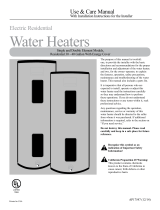
13
SYMPTOM PROBABLE CAUSE CORRECTIVE ACTION
No Hot Water
1. No Power to heater.
2. Loose wire connections.
3. Inoperative upper heating element.
4. Inoperative upper thermostat.
5. Open ECO.
1. Inoperative lower heating element.
2. Thermostat(s) set to low.
3. Inoperative thermostat(s).
4. Loose wire connection.
5. Sediment or lime build up on element(s).
6. High demand period.
7. Undersized heater.
8. Very cold inlet water to heater.
9. Plumbing connections reversed.
10. Damaged diptube.
Not Enough Hot
Water
Slow Hot Water
Recovery
1. Sediment or lime build up on element(s).
2. Loose wire connections.
3. Inoperative thermostat(s).
4. Derated heating element installed.
Over Heated
Water or
Continued
Operation
1. Thermostat not in contact with tank.
2. Grounded heating element(s).
3. Thermostat set too high.
4. Inoperative thermostat(s).
5. Inoperative ECO.
6. Undersized water heater.
1. Check fuses or circuit breakers in service
panel.
2. Check all wire connections.
3. Check heating element(s). Replace as
needed.
4. Check thermostat(s) operation. Replace as
needed.
5. Check ECO. Reset or replace
thermostat(s) as needed.
1. Check heating element(s), replace as
needed.
2. Increase thermostat setting.
3. Check thermostat(s), replace as needed.
4. Check all wire connection.
5. Remove heating element(s) and check for
lime build up.
6. Reduce demand.
7. Replace with larger heater.
8. Temper water to heater.
9. Correct plumbing connections.
10. Check dip tube, replace as needed.
1. Remove heating element(s) and check for
lime build up.
2. Check all wire connections.
3. Check thermostat(s), replace as needed.
4. Check terminal block of element for proper
voltage and wattage rating.
1. Position thermostat flush with tank surface.
2. Check heating element(s). Replace as
needed.
3. Adjust thermostat(s) to desired setting.
4. Check thermostat(s), replace as needed.
5. Check ECO, replace thermostat as
needed.
6. Replace with larger heater.
SERVICE
PROCEDURE
3. See Service Procedure
RE-II, Page 15.
4. See Service Procedure
RE-III, Page 16.
5. See Service Procedure
RE-I, Page 14.
1. See Service Procedure
RE-II, Page 15.
3. See Service Procedure
RE-III, Page 16.
5. See Service Procedure
RE-VI, Page 34.
10. See Service Procedure
RE-VII, Page 35.
1. See Service Procedure
RE-VI, Page 34.
3. See Service Procedure
RE-III, Page 16.
1. See Service Procedure
RE-V, Page 33.
2. See Service Procedure
RE-II, Page 15.
4. See Service Procedure
RE-III, Page 16.
5. See Service Procedure
RE-I, Page 14.
Page 13
Noisy (singing or
hissing) Elements
1. Lime formation on elements. 1. Remove and clean heating elements.
Replace as needed.
1. See Service Procedure
RE-VI, Page 34.
TROUBLESHOOTING
Quick Step Plan to Hot Water
1. TURN OFF power to water heater and check all wire
connections to ensure they are tight and corrosion free.
2. Turn power “ON” and determine that service voltage is
present, and the high limit (ECO) has not actuated
(see procedure on page 14).
3. Check for inoperative heating element (see procedure on page 15).
4. Check for proper thermostat operation (see procedures beginning on page 16). NOTE: Thermostat testing procedures
assume items 2 and 3 above are in working order.
WARNING
High voltage exposure. Use caution when
making voltage checks to avoid personal
injury.




















